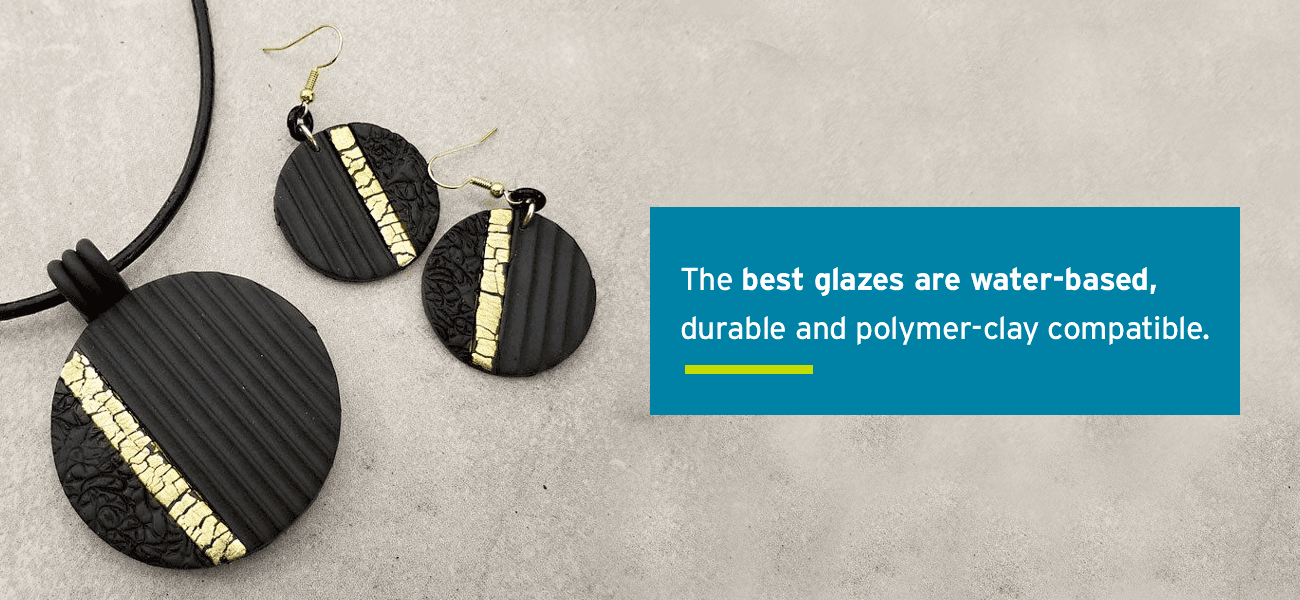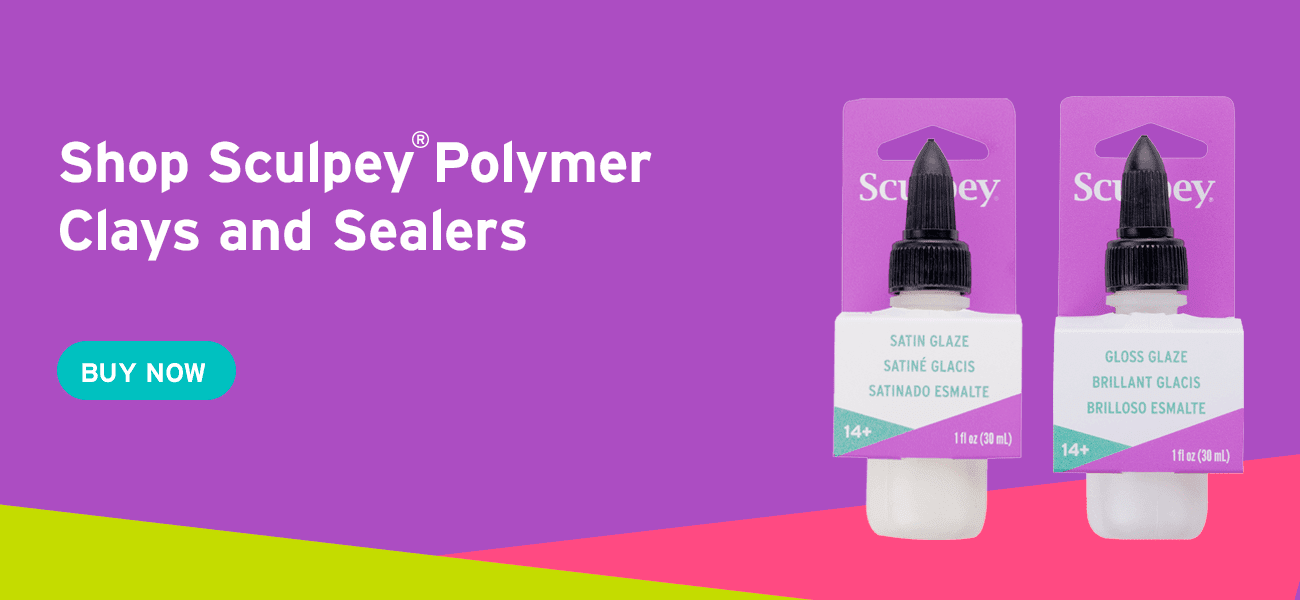
You’ve made a one-of-a-kind vase, ornament or pendant out of polymer clay, and now it’s baking in the oven to cure to completion. Once it cools, what comes next? Do you need to seal polymer clay before painting or using it, and, if so, which sealers are safe to use?
After all that creative work, the last thing you want to do is accidentally ruin your piece with an incompatible glaze, resulting in distorted colors or a tacky surface.
Learn how to seal polymer clay properly with durable matte, satin or glossy finishes recommended by top polymer clay professionals.
Table of Contents:
- Do You Need to Seal Polymer Clay?
- What Kind of Glaze Do You Use for Polymer Clay?
- What Are the Best Polymer Clay Sealers?
- What Varnish Should You Use for Polymer Clay?
- Shop Sculpey® Polymer Clays and Sealers
Do You Need to Seal Polymer Clay?
No, you don’t need to use a sealer with polymer clay. Baked clay is water-resistant and durable, even without a glaze. For a polished finish, sand and buff the cured clay using our wet/dry Sculpey Tools™ Sandpaper Variety Pack.
Wet the sandpaper and sand starting with 400 grit and work your way up to finer grits until you reach 1,000 or higher. Clean the dust and use a soft cloth to vigorously rub the clay in circular motions to buff the piece smooth with friction.
Why Add a Finish to Polymer Clay Creations?
While our unglazed clays are stable and naturally water-resistant when baked, many crafters prefer to seal projects for a variety of reasons:
- Protection: Glaze adds a layer of protection from dirt and wear.
- Paint prep: Sealed clay is a better foundation for acrylic paint application.
- Surface smoothing: Glaze conceals tiny imperfections in the clay surface.
- Color enhancement: A clear coat enhances the color of unpainted clay and painted designs.
- Added sheen: A finish creates a matte, satin or glossy surface.
Always test your glaze with these steps:
- Apply two layers of glaze to a small, hidden section.
- Allow the test spot to dry completely.
- Check for any interactions with the clay.
- Test scratch resistance and hardness.
If there are no observable reactions, proceed with glazing the entire project.
What Kind of Glaze Do You Use for Polymer Clay?
The best glazes are water-based, durable and polymer-clay compatible. Sculpey® glazes add that perfect finishing touch to make paint treatments and mica powders pop:
- Sculpey® Satin Glaze: Perfect for natural, earthy projects, our low-sheen water-soluble satin glaze seals clay creations.
- Sculpey® Gloss Glaze: Our gloss glaze provides an eye-catching shine for jewelry, picture frames and more.

What Are the Best Polymer Clay Sealers?
Polymer clay glazes are just one method to protect your projects. Before you select a clear finish, consider these qualities:
- Sheen: High gloss, satin or matte finishes affect your final look significantly. Do you want to mimic the glassy shine of porcelain or a more natural matte finish?
- Durability: The best polymer clay sealers are scratch- and peel-resistant, crystal clear and hard-drying. High-quality glazes won’t yellow or crack after use.
- Compatibility: Some glazes, like enamels, can react poorly with polymer clay. The incompatible finish may appear OK at first yet break down and distort over time.
Review this list to take out the guesswork and help you select the best polymer clay sealers to make your crafts shine:
Resin
Add epoxy enamel resin to baked clay to provide a dimensional, glass-like finish to your piece. As it hardens, resin undergoes a chemical reaction and contracts slightly, creating a subtle dome-like effect advantageous to jewelry makers. From earrings to cabochons, a glassy domed coating makes wearable art pop.While resin offers unique qualities, it has its drawbacks. Resins are tricky to work with and have a short shelf life of one year or less. Older resin may not cure, and it can yellow with age. Consider Liquid Sculpey® Clear for an easy-to-use resin alternative.
Liquid Polymer Clay
Liquid polymer clay is precisely what it sounds like — polymer clay in liquid form. After you bake your project, apply Liquid Sculpey® then bake again. Add this solution on top of paint and other treatments to finish beads, create faux stone effects and add shine. You have different options for liquid clay finishes:
- For a clear, glass-like surface: Achieve a 100% transparent coating with Liquid Sculpey® Clear. For that glassy, high-gloss look, hit your project with a heat gun after baking.
- For a low-sheen, translucent coating: Use a cosmetic sponge to lightly dab Liquid Sculpey® Translucent onto your project for a brushstroke-free matte topcoat.
Water-Based Sealants
The best sealants for polymer clay projects are water-based, and even among water-soluble options, not all formulas are created equal. Seasoned clayers utilize these finishes:
- Brush-on glazes: Apply glazes like Sculpey® Satin Glaze and Sculpey® Glaze Gloss with a paintbrush, cosmetic sponge or cotton swab.
- Floor finishes: Water-based floor finishes are a hidden gem of clay sealants. Light-bodied Pledge Floor Gloss and Varathane Gloss Floor Finish formulas have been the go-to choices for seasoned clayers for years because they dry quickly and won’t react with the clay.
- Varnishes and polyurethanes: Artists lacquer paintings with varnish, and this crystal-clear finish also benefits clayers. Varathane Polyurethane Satin and Jacquard Pearl Ex Varnish dry faster and are less odorous than oil-based polyurethanes — and these formulas are polymer clay compatible.
- Polycrylic: This popular water-based finish generally dries clear, but polycrylic can take on a milky appearance if applied heavily or over dark colors.
Polymer Clay Sealers to Avoid
The following finishes are not compatible with polymer clay:
- Skip the spray glazes: We do not recommend aerosol glazes. They can become sticky due to the interaction between the propellant and the clay.
- Avoid oil- and alcohol-based products: Enamels, solvents, shellacs and petroleum-based glazes damage polymer clay, cure improperly, peel or become brittle with time.
What Varnish Should You Use for Polymer Clay?
The best polymer clay finishes dry without tackiness, offer durability and are entirely compatible with polymer clay — which is why so many polymer clay crafters recommend these specific varnishes.
Matte Polymer Clay Varnishes
These water-based matte options offer a shine-free seal:
- Americana DuraClear Ultra Matte Varnish: This dead matte, zero-sheen finish is ideal for low-wear items made from Sculpey III®, Sculpey Premo™ and Sculpey Soufflé™.
- Golden Matte Polymer Varnish with UVLS: This acrylic polymer has ultraviolet light stabilizers (UVLS) to protect against UV radiation and color fading. This flat matte varnish works well with Sculpey Soufflé™ but scratches easily when used with Sculpey III® or Sculpey Premo™.
Have you ever painted on a matte finish only to return and find it’s dried shiny? There’s a simple reason for this — the bottle wasn’t mixed enough. Matte particles can settle at the bottom of the container, leaving the glossier base liquid at the top. Always stir — never shake — to mix the solution thoroughly before application.
Satin and Semi-Gloss Polymer Clay Varnishes
For a hint of a shine, reach for these finishes:
- Sculpey® Satin Glaze: This trusted low-sheen glaze is a clayer favorite to seal projects with a clean, modern finish.
- Minwax Polycrylic Clear Satin: This fast-drying topcoat cures to a vinyl-like surface and works best with Sculpey III® and Sculpey Soufflé™. The coating can scratch easily, especially with Sculpey Premo™, so it may not be the best option for heavily used objects.
- Varathane Polyurethane Satin: This high-performance varnish is durable and scratch-resistant, curing to a hard finish with zero stickiness.
Gloss Polymer Clay Varnishes
Looking for a glossy, wet-look coating? These products offer the best durability and highest shine:
- Sculpey® Gloss Glaze: Apply thin layers of this dependable high-shine topcoat to your projects for an attractive, glossy finish.
- Minwax Polycrylic Clear Gloss: This is best used with low-wear objects. The sheen is more satiny than a true gloss, but its shine is highest when used with Sculpey Soufflé™.
- Varathane Polyurethane Gloss: Excellent durability, scratch resistance, hardness and brilliance make this finish a preferred choice for heavily handled pieces.
Another high-gloss option is DecoArt Media Gloss Varnish — but only use it with Sculpey Soufflé™, as it tends to bead up on Sculpey Premo™ and other polymer clays.
Shop Sculpey® Polymer Clays and Sealers
Sculpey® has the supplies you need to get crafting! For more than 50 years, we’ve helped clayers take their creative ideas from imagination to reality with our innovative polymer clay products, tools and tutorials.
Shop Sculpey® online for polymer clays and glazes to make one-of-a-kind gifts, jewelry, mixed media projects and home décor with confidence. And be sure to check out our ever-growing how-to page and blog for clay project ideas and tips!



